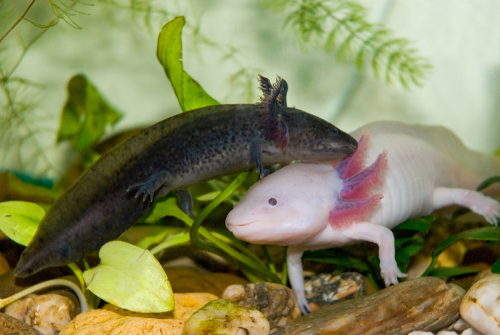Axolotls are a unique species of salamander that are native to Mexico. They are known for their ability to regenerate limbs and organs, as well as their unusual appearance. One question that many people have about axolotls is what they eat.
In the wild, axolotls are carnivorous and primarily eat small aquatic animals such as insects, crustaceans, and small fish. They have a voracious appetite and will eat almost anything that they can fit in their mouths.
In captivity, they can be fed a variety of foods including worms, brine shrimp, and commercial axolotl pellets. However, it is important to ensure that their diet is balanced and meets all of their nutritional needs.
Contents
Key Takeaways on What Do Axolotls Eat?
- Axolotls are carnivorous and primarily eat small aquatic animals in the wild.
- In captivity, they can be fed a variety of foods including worms, brine shrimp, and commercial axolotl pellets.
- It is important to ensure that their diet is balanced and meets all of their nutritional needs.
Check out these other related posts:
Axolotls in the Wild
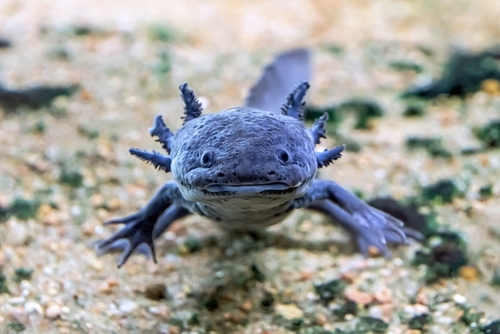
Axolotls are native to Mexico and can be found in the wild in the freshwater canals and lakes of Mexico City, specifically in Lake Xochimilco.
This lake is a unique ecosystem that is home to a variety of aquatic species, including the axolotl. Axolotls are also known to inhabit other freshwater bodies in the region, including Lake Chalco.
In their natural habitat, axolotls are carnivorous and primarily feed on small aquatic invertebrates, such as worms, snails, and insect larvae.
They are also known to eat small fish and other vertebrates. Axolotls are nocturnal animals, which means they are most active at night when they hunt for food.
Despite being a popular pet, axolotls are considered an invasive species in some areas outside of Mexico, where they have been introduced and have become established. In these areas, axolotls can negatively impact native species and their ecosystems.
Axolotls in Captivity
Axolotls are popular pets and can be found in many homes around the world. They are also commonly used in laboratory settings for scientific research. When keeping an axolotl in captivity, it is important to provide a suitable environment that meets their specific needs.
Tank Setup
Axolotls require a tank that is at least 20 gallons in size. The tank should have a secure lid to prevent the axolotl from escaping.
The substrate should be fine sand or gravel, and the tank should be decorated with plants and other hiding places. The water temperature should be kept between 60-68°F (15-20°C), and the pH level should be between 6.5-7.5.
Water Quality
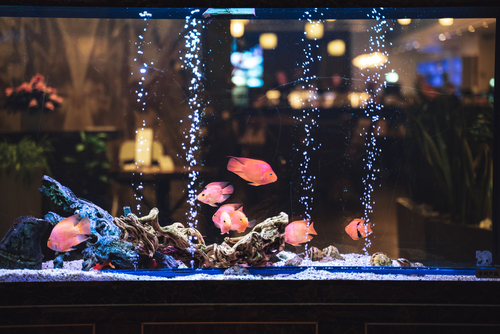
It is essential to keep the water clean in an axolotl tank. A good filtration system is necessary to keep the water chemistry stable. Axolotls produce a lot of waste, so regular water changes are also necessary. It is recommended to change 25% of the water every week.
Feeding
Axolotls are carnivores and require a diet of live or frozen foods such as bloodworms, brine shrimp, and small pieces of fish. It is important not to overfeed axolotls as they can become obese. A good rule of thumb is to feed them once a day or every other day.
Diet of Axolotls
Axolotls are carnivorous amphibians that require a diet rich in protein to maintain their health. In the wild, they primarily feed on small fish, worms, crustaceans, and insects. In captivity, they can be fed a variety of foods to meet their nutritional needs.
Live food is the best option for axolotls as it provides the necessary nutrients and exercise.
Earthworms, bloodworms, blackworms, daphnia, and brine shrimp are some of the most nutritious live foods that can be fed to axolotls. However, it is important to ensure that the live food is of an appropriate size to prevent impaction.
Axolotls can also be fed pellets and larvae, such as salmon pellets and blackworm larvae. These foods are convenient and can be purchased from pet stores. However, it is important to ensure that the pellets are of high quality and contain all the necessary nutrients.
Meat, such as beef, can also be fed to axolotls. However, it should be fed in moderation as it is high in fat and can cause health problems if fed in excess.
Axolotls should be fed once a day, and any uneaten food should be removed from the tank to prevent the buildup of harmful bacteria. It is also important to ensure that the axolotls have access to clean and fresh water at all times.
Supplementing Meals for Optimal Axolotl Nutrition
Ensuring axolotls receive a balanced, carnivorous diet is essential for their health and well-being. A varied axolotl diet comprising worms, brine shrimp, krill, and specialized pellets serves as a strong foundation for proper nutrition. To enhance their dietary intake, additional vitamins and minerals can be strategically supplemented.
For axolotls prone to frequent shedding, calcium baths could offer extra support for regeneration. Protein-rich foods like bloodworms and daphnia are excellent additions that align well with what axolotls eat in the wild, such as small fish and aquatic insects. Incorporating freeze-dried krill or spirulina occasionally can further boost the amino acids in their diet.
Signs Your Axolotl is Getting Enough Food
How does one gauge if an axolotl is receiving sufficient food? A healthy axolotl displays active behavior and a rounded, full belly. Their eagerness to eat is another positive indicator, often snapping at food before it even reaches the tank bottom.

While juvenile axolotls require daily protein-rich meals, adult axolotls only need feeding every 2-3 days. A lack of interest in food or a sunken stomach often signifies nutritional deficiencies, which could lead to stunted growth.
Dietary-Related Health Issues in Axolotls
A subpar diet can precipitate a variety of health issues. For instance, consumption of substrate materials like gravel can result in fatal impactions. Insects with hard exoskeletons, although part of the natural axolotl diet in the wild, can be challenging to digest in captivity. Undernourished axolotls become increasingly susceptible to infections and illnesses.
Conversely, overfeeding can lead to obesity, affecting organ function and mobility. Additionally, parasites in live food sources could induce dangerous anorexia.
Breeding Axolotls: Nutritional Considerations
When planning to breed axolotls, tailoring their diet is key to reproductive success. About a month before the breeding season, transitioning adult axolotls to a high-protein diet featuring blackworms, brine shrimp, and beef heart can promote robust egg production.
Supplementation with additional calcium ensures the formation of healthy eggshells. Post-laying, it’s vital to remove the female axolotl to prevent accidental consumption of the eggs. Upon hatching, larvae initially rely on their yolk sac for sustenance. At around two weeks of age, they can begin consuming newly hatched brine shrimp.
Also, a common question question that comes up when discussing axolotl diet is; are axolotls herbivores? And the answer is a resounding no. Their natural predilection for a carnivorous diet means that care must be taken to meet their specific nutritional needs, both in captivity and for those interested in mimicking what axolotls eat in the wild. With proper nutrition, axolotls can thrive, making them captivating and resilient pets for aquarists.
Axolotl Characteristics
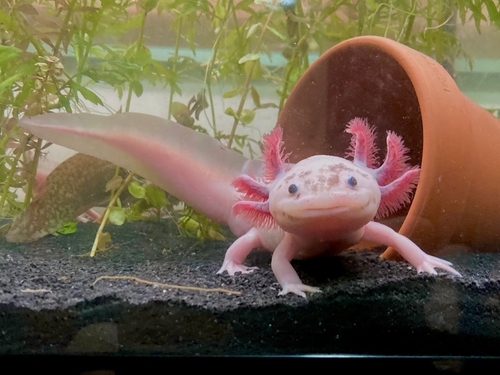
Axolotls are a type of amphibian that belong to the Ambystoma mexicanum species. They are commonly found in freshwater lakes and ponds in Mexico.
Axolotls are known for their unique ability to regenerate their limbs and other body parts, making them a popular subject for scientific research.
Axolotls have a distinctive appearance, with a brown or white body and pink gills that protrude from the sides of their head. They have large, expressive eyes that are capable of detecting even the slightest movements in their surroundings.
One of the most notable characteristics of axolotls is their gills. Unlike other amphibians, axolotls retain their gills throughout their entire life, making them fully aquatic. The gills allow them to extract oxygen from the water, which is essential for their survival.
Axolotls have a three-chambered heart, which is typical of amphibians. Their heart is responsible for pumping blood throughout their body, delivering oxygen and nutrients to their cells.
Unfortunately, axolotls are currently an endangered species. Their habitat is being destroyed by pollution and urbanization, and they are also hunted for food and medical research.
Conservation efforts are underway to protect these unique creatures and ensure their survival for future generations.
Conservation Status
Axolotls are considered critically endangered in the wild by the International Union for Conservation of Nature (IUCN).
Their population has declined significantly due to habitat loss, pollution, and over-harvesting for the pet trade and for use in traditional medicine.
In their native habitat of Lake Xochimilco and Lake Chalco in Mexico City, axolotls are threatened by water pollution and the loss of their natural habitat.
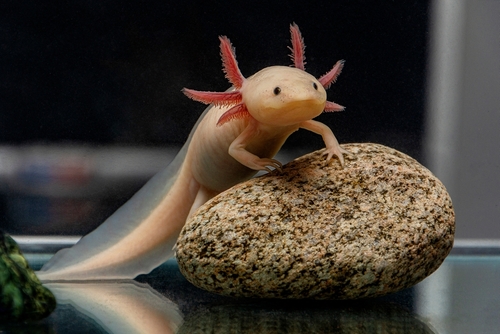
The lakes have been drained and filled in for urban development, leaving the remaining water highly polluted. This pollution affects the axolotls’ ability to breathe and reproduce.
In addition to habitat loss and pollution, the axolotl is also threatened by over-harvesting for the pet trade. Axolotls are popular pets due to their unique appearance and ease of care, but their popularity has led to a decline in their wild population.
This has prompted the Mexican government to ban the export of axolotls and to establish breeding programs to help conserve the species.
Conservation efforts are underway to protect the axolotl and its habitat. The Mexican government has established protected areas for the species, and conservation organizations are working to restore the lakes and reduce pollution.
Breeding programs have also been established to help maintain the genetic diversity of the species.
Despite these efforts, the future of the axolotl remains uncertain. Continued habitat loss and pollution, as well as the illegal pet trade, pose significant threats to the species.
It is important to continue conservation efforts to ensure the survival of this unique and fascinating creature.
Unique Features of Axolotls
Axolotls are a unique species of salamander that are native to Mexico. They are known for their ability to regenerate lost body parts, which is a rare trait among amphibians.
Axolotls can regrow limbs, spinal cords, and even parts of their brains. This remarkable ability has made them a popular subject of study for scientists who are interested in regeneration.
In addition to their regenerative abilities, axolotls are also unique in that they are able to remain in their larval form throughout their entire lives.
This means that they never fully develop into adult salamanders, and they retain their gills and aquatic lifestyle. This is in contrast to other salamanders, such as the tiger salamander, which undergo metamorphosis and become fully terrestrial as adults.
Axolotls are also carnivorous, and they primarily feed on small aquatic animals such as insects, crustaceans, and small fish. They are able to detect prey by using their sensitive lateral line system, which allows them to detect vibrations in the water.
Sexual maturity in axolotls occurs at around 18 months of age, and they are able to reproduce throughout their entire lives. They are able to lay hundreds of eggs at a time, and they are known for their ability to care for their young.
Conclusion
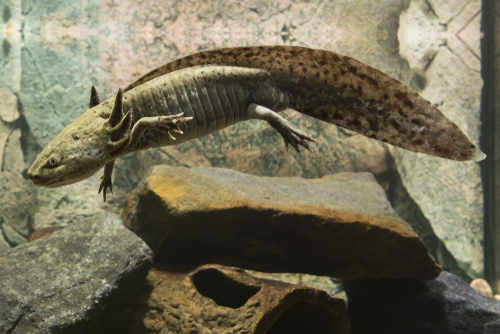
Axolotls are fascinating creatures that have unique dietary needs. They require a diet that is high in protein and low in fat. Axolotls are carnivorous and prefer live food such as worms, insects, and small fish.
They can also eat frozen or dried food, but it is important to ensure that the food is appropriate for their size and age.
Axolotls should be fed small portions of food several times a day to prevent overfeeding and obesity. It is important to remove any uneaten food from the tank to prevent contamination of the water.
Axolotls should also be provided with a variety of food to ensure that they receive all the necessary nutrients.
It is important to note that axolotls should not be fed with human food, as it can cause digestive problems and even death.
In addition, axolotls should not be fed with food that is too large for them to swallow, as it can cause choking or blockages in their digestive system.
Frequently Asked Questions
What is the ideal diet for axolotls?
Axolotls are carnivorous and their ideal diet consists of protein-rich foods such as earthworms, bloodworms, brine shrimp, and small pieces of fish. It is recommended to feed them a variety of foods to ensure they receive all the necessary nutrients.
How often should I feed my axolotl?
Axolotls should be fed once a day, and only as much as they can consume in a few minutes. Overfeeding can lead to obesity and other health problems.
What are some common foods that axolotls eat?
Some common foods that axolotls eat include earthworms, bloodworms, brine shrimp, small pieces of fish, and pellets specifically formulated for axolotls.
Can axolotls eat vegetables and fruits?
Axolotls are not herbivores and do not require vegetables or fruits in their diet. In fact, feeding them these types of foods can cause digestive problems.
What are some foods that axolotls should avoid?
Axolotls should avoid foods that are high in fat, such as beef heart, and foods that are difficult to digest, such as mealworms. They should also not be fed insects or other live prey that can potentially harm them.
How do I know if my axolotl is getting enough food?
A healthy axolotl will have a plump, rounded belly and will be active and alert. If an axolotl appears lethargic or has a sunken belly, it may not be getting enough food.

Ian Sterling, founder of Fishlab.com, began his aquarium journey over 30 years ago, driven by a deep fascination for fish and their diverse personalities. His website, Fishlab.com, is dedicated to making fishkeeping accessible and enjoyable, offering beginner-friendly guidance, expert insights, and a community for aquarists to connect and share experiences.


